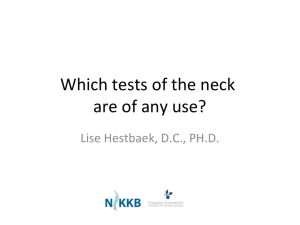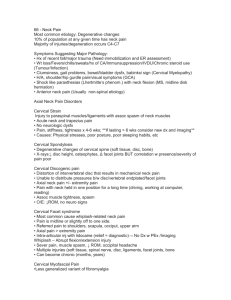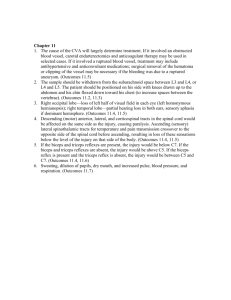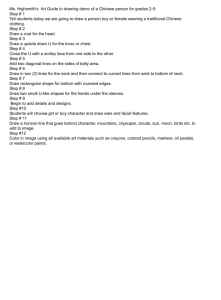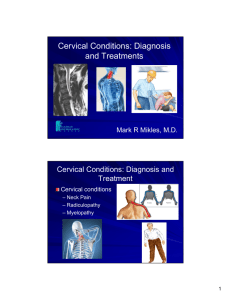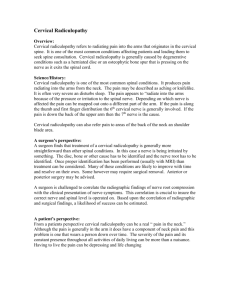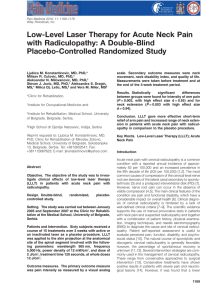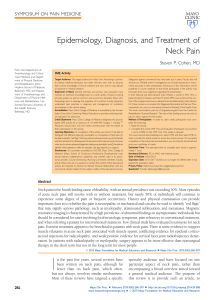cervical spondylosis dr tp moja steve biko academic hospital
advertisement
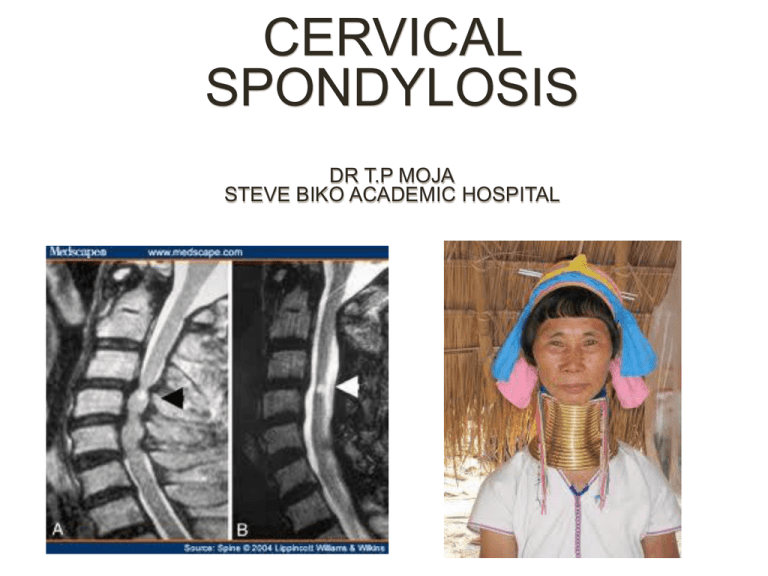
CERVICAL SPONDYLOSIS DR T.P MOJA STEVE BIKO ACADEMIC HOSPITAL Pathophysiology Disc degeneration -nucleus pulposus loses water content, fissuring, loss of height and bulging annulus. -acute rupture and herniation may occur Secondary changes due to increased and uneven loading of forces - Vertebral osteophytes - Facet and uncovertebral joint osteoarthritis and hypertrophy - Ligamentum flavum becomes thickened and may ossify - Spine deformity due to segmental instability Degenerative spondylolistheses Degenerative kyphosis or scoliosis • Narrowing of the central canal, lateral recesses and foramina with subsequent neural and vascular compression CERVICAL SPINE XRAY MRI CERVICAL SPINE Clinical Presentation Asymptomtic with incidental radiographic findings Symptomatic - in most cases: onset is slow and insidious . However some cases may be acute eg hyperextension injury in minor trauma or acute disc herniation Neck pain Myelopathy Radiculopathy Neck pain • Occurs if there is a disc extrusion • Nerve root compression • Facet joint arthritis • Segmental instability • Often poorly localized • May radiate to the occipital region, shoulders, interscapular. • There may be associated stiffness of the neck from muscle spasm Myelopathy • May be complex and variable • Most cases seem to present with a central cord syndrome, rarely brown squard, or complete myelopathy • Motor • -upper limbs: LMN Weakness •Clumsiness of the hands. Muscle wasting. Absent biceps reflex, inverted reflex, Triceps reflex may be brisk. Positive Hoffman reflex • -Lower limbs: Spasticity, difficulty walking. No or slight weakness. • Sphincters: usually no symptoms. Rarely mild bladder symptoms. ? Prostate • Sensory - No involvement - Patchy sensory loss - Paraesthesia in the hands, sometimes the feet and legs - May be asymmetrical or symmetrical - Different from radiculopathy in that it is not in a specific dermatomes - Lhermittes’s sign Radiculopathy • May be acute if due to a disc protrusion • Slow and insidious if due to an osteophyte • Most common nerve root is C6 • Neck pain and shoulder pain. Pain radiates down the biceps, then the lateral aspect of the forearm then the thumb and index finger. • Head may be tilted to the affected side due to muscle spasm. Pain made worse by neck extension, relieved by neck flexion and shoulder abduction. • Often numbness, more often hand and fingers • Chronic cases – wasting and fasciculations of biceps and brachioradialis muscle. • Weakness of elbow flexion (Thumbnose), and wrist extension. • Absent biceps and brachioradialis reflex C5 nerve root radiculopathy • - Neck pain • - Shoulder pain, pain over the lateral aspect of the upper arm. • - Numbness or paraesthesia over the lateral aspect of the upper arm. • - Weakness of deltoid and biceps muscles, with absent biceps reflex •In severe cases, wasting of the deltoid and biceps muscles Treatment Neck Pain -Conservative -Rarely, surgery Myelopathy -Surgery in most cases -Some may stabilize on conservative Acute radiculopathy -Conservative -Surgery if indicated Chronic radiculopathy -Most cases, surgery Conservative treatment • Medication: Analgesia NSAIDS Diazepam Baclofen Carbamazepine, Gabapentin, Lyrica • Physiotherapy: Range of motion exercises Isometric exercises Heat and massage • Traction: • Neck collar Continuous or intermittent halter traction Soft neck collar < 1 week • Facet and Medial branch block – Cortisone, L.A, Radiofrequency SURGERY • Anterior decompression – Anterior cervical discectomy and fusion – Corpectomy and fusion • Posterior decompression – Laminaplasty – Laminectomy
